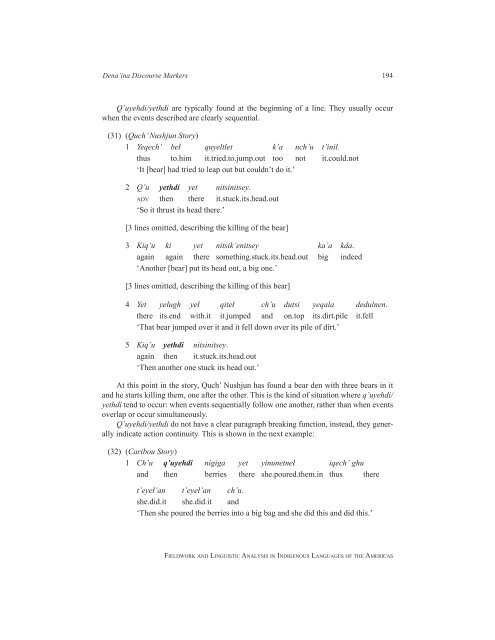Fieldwork and Linguistic Analysis in Indigenous ... - ScholarSpace
Fieldwork and Linguistic Analysis in Indigenous ... - ScholarSpace
Fieldwork and Linguistic Analysis in Indigenous ... - ScholarSpace
You also want an ePaper? Increase the reach of your titles
YUMPU automatically turns print PDFs into web optimized ePapers that Google loves.
Dena’<strong>in</strong>a Discourse Markers 194<br />
Q’uyehdi/yethdi are typically found at the beg<strong>in</strong>n<strong>in</strong>g of a l<strong>in</strong>e. They usually occur<br />
when the events described are clearly sequential.<br />
(31) (Quch’ Nushjun Story)<br />
1 Yeqech’ beł quyeltlet k’a nch’u t’<strong>in</strong>il.<br />
thus to.him it.tried.to.jump.out too not it.could.not<br />
‘It [bear] had tried to leap out but couldn’t do it.’<br />
2 Q’u yethdi yet nits<strong>in</strong>itsey.<br />
adv then there it.stuck.its.head.out<br />
‘So it thrust its head there.’<br />
[3 l<strong>in</strong>es omitted, describ<strong>in</strong>g the kill<strong>in</strong>g of the bear]<br />
3 Kiq’u ki yet nitsik’enitsey ka’a kda.<br />
aga<strong>in</strong> aga<strong>in</strong> there someth<strong>in</strong>g.stuck.its.head.out big <strong>in</strong>deed<br />
‘Another [bear] put its head out, a big one.’<br />
[3 l<strong>in</strong>es omitted, describ<strong>in</strong>g the kill<strong>in</strong>g of this bear]<br />
4 Yet yelugh yeł qiteł ch’u dutsi yeqala dedulnen.<br />
there its.end with.it it.jumped <strong>and</strong> on.top its.dirt.pile it.fell<br />
‘That bear jumped over it <strong>and</strong> it fell down over its pile of dirt.’<br />
5 Kiq’u yethdi nits<strong>in</strong>itsey.<br />
aga<strong>in</strong> then it.stuck.its.head.out<br />
‘Then another one stuck its head out.’<br />
At this po<strong>in</strong>t <strong>in</strong> the story, Quch’ Nushjun has found a bear den with three bears <strong>in</strong> it<br />
<strong>and</strong> he starts kill<strong>in</strong>g them, one after the other. This is the k<strong>in</strong>d of situation where q’uyehdi/<br />
yethdi tend to occur: when events sequentially follow one another, rather than when events<br />
overlap or occur simultaneously.<br />
Q’uyehdi/yethdi do not have a clear paragraph break<strong>in</strong>g function, <strong>in</strong>stead, they generally<br />
<strong>in</strong>dicate action cont<strong>in</strong>uity. This is shown <strong>in</strong> the next example:<br />
(32) (Caribou Story)<br />
1 Ch’u q’uyehdi nigiga yet y<strong>in</strong>unetneł iqech’ ghu<br />
<strong>and</strong> then berries there she.poured.them.<strong>in</strong> thus there<br />
t’eyeł’an t’eyeł’an ch’u.<br />
she.did.it she.did.it <strong>and</strong><br />
‘Then she poured the berries <strong>in</strong>to a big bag <strong>and</strong> she did this <strong>and</strong> did this.’<br />
fieldwork <strong>and</strong> l<strong>in</strong>guistic analysis <strong>in</strong> <strong>in</strong>digenous languages of the americas

















